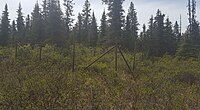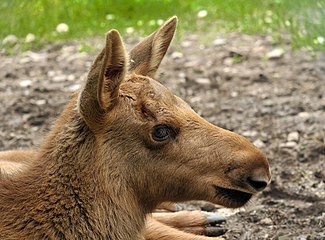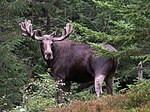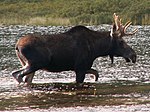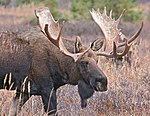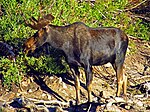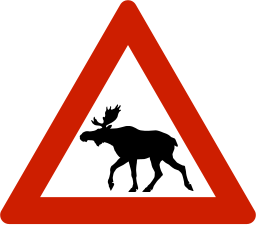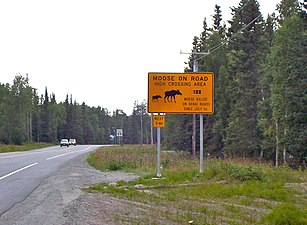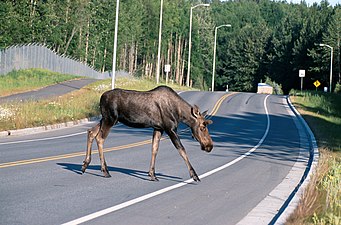Moose
| Moose Temporal range:
| |
|---|---|

| |
| A bull (male) moose in Alaska, US | |
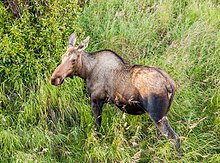
| |
| A cow (female) moose in Alaska, US | |
| Scientific classification | |
| Domain: | Eukaryota |
| Kingdom: | Animalia |
| Phylum: | Chordata |
| Class: | Mammalia |
| Order: | Artiodactyla |
| Family: | Cervidae |
| Subfamily: | Capreolinae |
| Tribe: | Alceini |
| Genus: | Alces Gray, 1821 |
| Species: | A. alces
|
| Binomial name | |
| Alces alces | |

| |
| Moose range map | |
| Synonyms | |
| |
The moose (pl.: 'moose'; used in North America) or elk (pl.: 'elk' or 'elks'; used in
Hunting shaped the relationship between moose and humans, both in Eurasia and North America. Prior to the colonial era (around 1600-1700 CE), moose were one of many valuable sources of sustenance for certain tribal groups and First Nations. Hunting and habitat loss have reduced the moose's range; this fragmentation has led to sightings of "urban moose" in some areas.
The moose has been reintroduced to some of its former habitats. Currently, the greatest populations occur in
Predominantly a
Taxonomy
Etymology
Alces alces is called a "moose" in
In
The word "elk" remained in usage because of English-speakers' familiarity with the species in Continental Europe; however, without any living animals around to serve as a reference, the meaning became rather vague, and by the 17th century "elk" had a meaning similar to "large deer".[7] Dictionaries of the 18th century simply described "elk" as a deer that was "as large as a horse".[8]
The word "moose" had first entered English by 1606
Description

On average, an adult moose stands 1.4–2.1 m (4 ft 7 in – 6 ft 11 in) high at the shoulder, which is more than 30 centimetres (1 ft) higher than the next-largest deer on average, the
Antlers


Bull moose have antlers like other members of the deer family. The size and growth rate of antlers is determined by diet and age.[20] Size and symmetry in the number of antler points signals bull moose health and cows may select mates based on antler size and symmetry.[21] Bull moose use their antlers to display dominance, to discourage competition, and to spar or fight rivals.[20]
The male's antlers grow as cylindrical beams projecting on each side of the head at right angles to the midline of the skull, and then fork. The lower prong of this fork may be either simple, or divided into two or three tines, with some flattening. Most moose have antlers that are broad and palmate (flat) with tines (points) along the outer edge.[20] Within the ecologic range of the moose in Europe, northern populations display the palmate pattern of antlers, while the antlers of European moose residing the southerly portion of its range are typically of the cervina dendritic pattern and comparatively small, perhaps due to evolutionary pressures of hunting by humans, who prize the large palmate antlers. European moose with antlers intermediate between the palmate and the dendritic form are found in the middle of the north–south range.[22] Moose with antlers have more acute hearing than those without antlers; a study of trophy antlers using a microphone found that the palmate antler acts as a parabolic reflector, amplifying sound at the moose's ear.[23]
The antlers of mature Alaskan adult bull moose (5 to 12 years old) have a normal maximum spread greater than 200 centimeters (79 in). By the age of 13, moose antlers decline in size and symmetry. The widest spread recorded was 210 centimeters (83 in) across. An Alaskan moose also holds the record for the heaviest weight at 36 kilograms (79 lb).[20]
Antler beam diameter, not the number of tines, indicates age.[20] In North America, moose (A. a. americanus) antlers are usually larger than those of Eurasian moose and have two lobes on each side, like a butterfly. Eurasian moose antlers resemble a seashell, with a single lobe on each side.[20] In the North Siberian moose (A. a. bedfordiae), the posterior division of the main fork divides into three tines, with no distinct flattening. In the common moose (A. a. alces) this branch usually expands into a broad palmation, with one large tine at the base and a number of smaller snags on the free border. There is, however, a Scandinavian breed of the common moose in which the antlers are simpler and recall those of the East Siberian animals. The palmation appears to be more marked in North American moose than in the typical Scandinavian moose.

After the mating season males drop their antlers to conserve energy for the winter. A new set of antlers will then regrow in the spring. Antlers take three to five months to fully develop, making them one of the fastest growing animal organs. Antler growth is "nourished by an extensive system of blood vessels in the skin covering, which contains numerous hair follicles that give it a 'velvet' texture."[20] This requires intense grazing on a highly-nutritious diet. By September the velvet is removed by rubbing and thrashing which changes the colour of the antlers. Immature bulls may not shed their antlers for the winter, but retain them until the following spring. Birds, carnivores and rodents eat dropped antlers as they are full of protein and moose themselves will eat antler velvet for the nutrients.[20]
If a bull moose is
In extremely rare circumstances, a cow moose may grow antlers. This is usually attributed to a hormone imbalance.[27]
Proboscis and olfaction
The moose proboscis is distinctive among living cervids due to its large size; it also features nares that can be sealed shut when the moose is browsing aquatic vegetation. The moose proboscis likely evolved as an adaptation to aquatic browsing, with loss of the rhinarium, and development of a superior olfactory column separate from an inferior respiratory column.[28] This separation contributes to the moose's keen sense of smell, which they employ to detect water sources, to find food under snow, and to detect mates or predators.[29][28]
Hooves

As with all members of the order Artiodactyla (
Skin and fur
Moose skin is typical of the
Dewlap
Both male and female moose have a dewlap or bell,[36] which is a fold of skin under the chin. Its exact function is unknown, but some morphologic analyses suggest a cooling (thermoregulatory) function.[37] Other theories include a fitness signal in mating, as a visual and olfactory signal, or as a dominance signal by males, as are the antlers.[38]
Ecology and biology
Diet
The moose is a browsing herbivore and is capable of consuming many types of plant or fruit. The average adult moose needs to consume 96 megajoules (23,000 kilocalories) per day to maintain its body weight.[39] Much of a moose's energy is derived from terrestrial vegetation, mainly consisting of forbs and other non-grasses, and fresh shoots from trees such as willow and birch. As these terrestrial plants are rather low in sodium, as much as half of its diet usually consists of aquatic plants, including lilies and pondweed,[40] which while lower in energy content, provide the moose with its sodium requirements.[41] In winter, moose are often drawn to roadways, to lick salt that is used as a snow and ice melter.[42] A typical moose, weighing 360 kg (794 lb), can eat up to 32 kg (71 lb) of food per day.[41]
Moose lack upper front
Moose are excellent swimmers and are known to wade into water to eat aquatic plants. This trait serves a second purpose in cooling down the moose on summer days and ridding itself of black flies. Moose are thus attracted to marshes and river banks during warmer months as both provide suitable vegetation to eat and water to wet themselves in. Moose have been known to dive over 5.5 metres (18 ft) to reach plants on lake bottoms,[48] and the complex snout may assist the moose in this type of feeding. Moose are the only deer that are capable of feeding underwater.[49] As an adaptation for feeding on plants underwater, the nose is equipped with fatty pads and muscles that close the nostrils when exposed to water pressure, preventing water from entering the nose.[50] Other species can pluck plants from the water too, but these need to raise their heads in order to swallow.
Moose are not grazing animals but browsers (concentrate selectors). Like giraffes, moose carefully select foods with less fiber and more concentrations of nutrients. Thus, the moose's digestive system has evolved to accommodate this relatively low-fiber diet. Unlike most hooved, domesticated animals (ruminants), moose cannot digest hay, and feeding it to a moose can be fatal.[51][52] The moose's varied and complex diet is typically expensive for humans to provide, and free-range moose require a lot of forested hectarage for sustainable survival, which is one of the main reasons moose have never been widely domesticated.[citation needed]
Natural predators


A full-grown moose has few enemies except

In some areas, moose are the primary source of food for wolves. Moose usually flee upon detecting wolves. Wolves usually follow moose at a distance of 100 to 400 meters (300 to 1,300 ft), occasionally at a distance of two to three kilometers (1 to 2 mi). Attacks from wolves against young moose may last seconds, though sometimes they can be drawn out for days with adults. Sometimes, wolves will chase moose into shallow streams or onto frozen rivers, where their mobility is greatly impeded. Moose will sometimes stand their ground and defend themselves by charging at the wolves or lashing out at them with their powerful hooves. Wolves typically kill moose by tearing at their haunches and
Research into moose predation suggests that their response to perceived threats is learned rather than instinctual. In practical terms this means moose are more vulnerable in areas where wolf or bear populations were decimated in the past but are now rebounding. These same studies suggest, however, that moose learn quickly and adapt, fleeing an area if they hear or smell wolves, bears, or scavenger birds such as ravens.[72]
Moose are also subject to various diseases and forms of parasitism. In northern Europe, the moose botfly is a parasite whose range seems to be spreading.[73]
Parasites
Moose typically carry a heavy burden of parasites, both externally and internally. Parasitosis is an important cause of moose morbidity and mortality and also contributes to vulnerability to predators. lungworm, and roundworm.
Social structure and reproduction
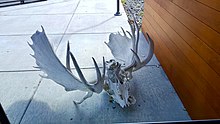
Moose are mostly diurnal. They are generally solitary with the strongest bonds between mother and calf. Although moose rarely gather in groups, there may be several in close proximity during the mating season.
Rutting and mating occurs in September and October. During the rut, mature bulls will cease feeding completely for a period of approximately two weeks; this fasting behavior has been attributed to neurophysiological changes related to redeployment of olfaction for detection of moose urine and moose cows.[78] The males are polygynous and will seek several females to breed with. During this time both sexes will call to each other. Males produce heavy grunting sounds that can be heard from up to 500 metres (1,600 ft) away, while females produce wail-like sounds.[79] Males will fight for access to females. Initially, the males assess which of them is dominant and one bull may retreat, however, the interaction can escalate to a fight using their antlers.
Female moose have an eight-month gestation period, usually bearing one calf, or twins if food is plentiful,[80] in May or June.[81] Twinning can run as high as 30% to 40% with good nutrition[82] Newborn moose have fur with a reddish hue in contrast to the brown appearance of an adult. The young will stay with the mother until just before the next young are born. The life span of an average moose is about 15–25 years. Moose populations are stable at 25 calves for every 100 cows at 1 year of age. With availability of adequate nutrition, mild weather, and low predation, moose have a huge potential for population expansion.[82]
-
(newborn)
Calves nursing in spring. -
(3 months)
Calves stay near their mothers at all times. -
(9 months)
This calf is almost ready to leave its mother. -
(10–11 months)
This yearling was probably recently chased away by its pregnant mother.
Aggression
Moose are not typically aggressive towards humans, but will be aggressive when provoked or frightened. Moose attack more people than

Moose are unpredictable. They are most likely to attack if annoyed or harassed, or if approached too closely. A moose that has been harassed may vent its anger on anyone in the vicinity, and they often do not make distinctions between their tormentors and innocent passersby.[
Moose cows are more likely to emit protest moans when courted by small males. This attracts the attention of large males, promotes male-male competition and violence, reduces harassment of cows by small males, and increases mating opportunities with large males.[89] This in turn means that the cow moose has at least a small degree of control over which bulls she mates with.[90]
Moose often show aggression to other animals as well, especially predators. Bears are common predators of moose calves and, rarely, adults. Alaskan moose have been reported to successfully fend off attacks from both black and brown bears. Moose have been known to stomp attacking wolves, which makes them less preferred as prey to the wolves. Moose are fully capable of killing bears and wolves. In one rare event, a female moose killed two adult male wolves.[91][92] A moose of either sex that is confronted by danger may let out a loud roar, more resembling that of a predator than a prey animal. European moose are often more aggressive than North American moose, such as the moose in Sweden, which often become very agitated at the sight of a predator. However, like all ungulates known to attack predators, the more aggressive individuals are always darker in color, with the darkest coloring usually in areas facing the opponent, thus serving as a natural warning to other animals.[49]
Habitat, range, and distribution
Habitat

Moose require habitat with adequate edible plants (e.g., pond grasses, young trees and shrubs), cover from predators, and protection from extremely hot or cold weather. Moose travel among different habitats with the seasons to address these requirements.[93] Moose are cold-adapted mammals with thickened skin, dense, heat-retaining coat, and a low surface:volume ratio, which provides excellent cold tolerance but poor heat tolerance. Moose survive hot weather by accessing shade or cooling wind, or by immersion in cool water. In hot weather, moose are often found wading or swimming in lakes or ponds. When heat-stressed, moose may fail to adequately forage in summer and may not gain adequate body fat to survive the winter. Also, moose cows may not calve without adequate summer weight gain. Moose require access to both young forest for browsing and mature forest for shelter and cover. Forest disturbed by fire and logging promotes the growth of fodder for moose. Moose also require access to mineral licks, safe places for calving and aquatic feeding sites.[93]
Moose avoid areas with little or no snow as this increases the risk of predation by wolves and avoid areas with deep snow, as this impairs mobility. Thus, moose select habitat on the basis of trade-offs between risk of predation, food availability, and snow depth.[94] With reintroduction of bison into boreal forest, there was some concern that bison would compete with moose for winter habitat, and thereby worsen the population decline of moose. However, this does not appear to be a problem. Moose prefer sub-alpine shrublands in early winter, while bison prefer wet sedge valley meadowlands in early winter. In late winter, moose prefer river valleys with deciduous forest cover or alpine terrain above the tree line, while bison preferred wet sedge meadowlands or sunny southern grassy slopes.[95]
North America
After expanding for most of the 20th century, the moose population of North America has been in steep decline since the 1990s. Populations expanded greatly with improved habitat and protection, but now the moose population is declining rapidly.[96] This decline has been attributed to opening of roads and landscapes into the northern range of moose, allowing deer to become populous in areas where they were not previously common. This encroachment by deer on moose habitat brought moose into contact with previously unfamiliar pathogens, including brainworm and liver fluke, and these parasites are believed to have contributed to the population decline of moose.[97][98]
In
In northeastern North America, the Eastern moose's history is very well documented: moose meat was a staple in the diet of indigenous peoples for centuries. The common name "moose" was brought into English from the word used by those who lived in present day coastal Rhode Island. The indigenous people often used moose hides for leather and its meat as an ingredient in pemmican, a type of dried jerky used as a source of sustenance in winter or on long journeys.[107]
The historical range of the subspecies extended from well into Quebec, the Maritimes, and Eastern Ontario south to include all of New England finally ending in the very northeastern tip of Pennsylvania in the west, cutting off somewhere near the mouth of the Hudson River in the south. The moose has been extinct in much of the eastern U.S. for as long as 150 years, due to colonial era overhunting and destruction of its habitat: Dutch, French, and British colonial sources all attest to its presence in the mid 17th century from Maine south to areas within 160 kilometers (100 mi) of present-day Manhattan. However, by the 1870s, only a handful of moose existed in this entire region in very remote pockets of forest; less than 20% of suitable habitat remained.[108]
Since the 1980s, however, moose populations have rebounded, thanks to regrowth of plentiful food sources,
In the Midwest U.S., moose are primarily limited to the upper Great Lakes region, but strays, primarily immature males, have been found as far south as eastern Iowa.[118] For unknown reasons, the moose population is declining rapidly in the Midwest.[96]
Moose were successfully introduced on
-
Cow and bull moose
-
Cow moose
-
Moose calf
Decline in population
Since the 1990s, moose populations have declined dramatically in much of
Europe and Asia

Biebrzański Park Narodowy, Poland

In
By the early 20th century, the last strongholds of the European moose appeared to be in Fennoscandian areas and patchy tracts of Russia, with a few migrants found in what is now Estonia and Lithuania. The USSR and Poland managed to restore portions of the range within its borders (such as the 1951 reintroduction into Kampinos National Park and the later 1958 reintroduction in Belarus), but political complications limited the ability to reintroduce it to other portions of its range. Attempts in 1930 and again in 1967 in marshland north of Berlin were unsuccessful. At present in Poland, populations are recorded in the Biebrza river valley, Kampinos, and in Białowieża Forest. It has migrated into other parts of Eastern Europe and has been spotted in eastern and southern Germany.[133][134] Unsuccessful thus far in recolonizing these areas via natural dispersal from source populations in Poland, Belarus, Ukraine, Czech Republic, and Slovakia, it appears to be having more success migrating south into the Caucasus. It is listed under Appendix III of the Bern Convention.[135][136]
In 2008, two moose were reintroduced into the Scottish Highlands[137][138] in Alladale Wilderness Reserve.[139] The moose disappeared as a breeding species from Denmark about 4,500 years ago (in the last century, a very small number have lived for periods in Zealand without establishing a population after swimming across the Øresund from Sweden),[140] but in 2016-17 ten were introduced to Lille Vildmose from Sweden. In 2020, this population had increased to about 25 animals.[141]
The East Asian moose populations confine themselves mostly to the territory of
The size of the moose varies. Following
New Zealand
In 1900, an attempt to introduce moose into the Hokitika area failed; then in 1910 ten moose (four bulls and six cows) were introduced into Fiordland. This area is considered a less than suitable habitat, and subsequent low numbers of sightings and kills have led to some presumption of this population's failure.[142] The last proven sighting of a moose in New Zealand was in 1952.[143] However, a moose antler was found in 1972, and DNA tests showed that hair collected in 2002 was from a moose. There has been extensive searching, and while automated cameras failed to capture photographs, evidence was seen of bedding spots, browsing, and antler marks.[144]
Evolutionary history


Moose are members of the subfamily Capreolinae. Members of the moose lineage extend back into the Pliocene-Early Pleistocene.[145] Some scientists group the moose and all its extinct relatives into one genus, Alces[146], while others, such as Augusto Azzaroli, restrict Alces to the living species, placing the fossil species into the genera Cervalces (stag moose) and Libralces.[145]
The earliest known species in the moose lineage is
Libralces gallicus was followed by
Populations
North America:
- In Canada: There are an estimated 500,000 to 1,000,000 moose,[152] with 150,000 in Newfoundland in 2007 descended from just four that were introduced in the 1900s.[153]
- In United States: There are estimated to be around 300,000:
- Alaska: The state's Department of Fish and Game estimated 200,000 in 2011.[154]
- Northeast: A wildlife ecologist estimated 50,000 in New York and New England in 2007, with expansion expected.[116]
- Rocky Mountain states: Wyoming is said to have the largest share in its six-state region, and its Fish and Game Commission estimated 7,692 in 2009.[155]
- Upper Midwest: Michigan 2000 on Isle Royale (2019) and an estimated 433 (in its Upper Peninsula) in 2011,[156][157] Wisconsin, 20–40 (close to its border with Michigan) in 2003, Minnesota 5600 in its northeast in 2010,[158] and under 100 in its northwest in 2009;[159] North Dakota closed, due to low moose population, one of its moose-hunting geographic units in 2011, and issued 162 single-kill licenses to hunters, each restricted to one of the remaining nine units.[160]
Europe and Asia:
- Finland: In 2009, there was a summer population of 115,000.[161]
- Norway: In 2009, there were a winter population of around 120,000.[162] In 2015 31,131 moose were shot. In 1999, a record number of 39,422 moose were shot.[163]
- Latvia: in 2015, there were 21,000.[164]
- Estonia: 13,260[165]
- Lithuania: around 14,000 in 2016[166]
- Poland: 28,000[167]
- Czech Republic: maximum of 50[168]
- Russia: In 2007, there were approximately 600,000.[169]
- Sweden: Summer population is estimated to be 300,000–400,000. Around 100,000 are shot each fall.[170][171] About 10,000 are killed in traffic accidents yearly.[172]
Subspecies
| European elk | A. a. alces | Finland, Sweden, Norway, Latvia, Estonia and Russia. No longer present in central and western Europe except for Poland, Lithuania and Belarus, with a certain population in the Czech Republic, Slovakia and northern Ukraine, including Bohemia since the 1970s; recently sighted in eastern Germany (the range formerly included France, Switzerland and the Benelux nations). Population increasing and regaining territory. Males weigh about 320 to 475 kg (705 to 1,047 lb) and females weigh 275 to 375 kg (606 to 827 lb) in this mid-sized subspecies. Shoulder height ranges from 1.7 to 2.1 m (5 ft 7 in to 6 ft 11 in).[173] |
| Yakutia, Mid-Siberian or Lena elk[174] | A. a. pfizenmayeri | Eastern . Similar in size to the western moose of Canada and the United States. |
| Ussuri, Amur or Manchurian elk[174][175] | A. a. cameloides | Ranges from the Amur-Ussuri region of far eastern Russia, as well as the northeastern part of China. Ussuri elk are different from other elk subspecies in that their antler size is much smaller, or they lack antlers entirely. Even adult bulls' antlers are small and cervine, with little palmation. The smallest subspecies in both Eurasia and the world, with both males and females standing only 1.65 to 1.85 m (5 ft 5 in to 6 ft 1 in) at the shoulder and weighing between 200 and 350 kg (441 and 772 lb).[176] |
| Chukotka or East Siberian elk[174] | A. a. buturlini | Ranges from northeastern Siberia from the Alazeya River basin east to the Kolyma and Anadyr basins and south through the Koryak range and the Kamchatka Peninsula . The largest subspecies in Eurasia. Males can grow up to 2.15 m (7 ft 1 in) tall and weigh between 500 and 725 kg (1,102 and 1,598 lb); females are somewhat smaller.
|
| Eastern moose | A. a. americana | Eastern Canada, including eastern Atlantic Provinces and the northeastern United States, including Maine, New Hampshire, Vermont, Massachusetts, Rhode Island, Connecticut and northern New York near the Adirondack Mountains. Population increasing. This is a fairly small-bodied subspecies, females weighing an average of 270 kg (595 lb), males weighing an average of 365 kg (805 lb) and males standing up to approximately 2 m (6.6 ft) at the shoulder.
|
| Western moose | A. a. andersoni | British Columbia to western Ontario, the eastern Yukon, the Northwest Territories, southwestern Nunavut, Michigan (the Upper Peninsula), northern Wisconsin, northern Minnesota and northeastern North Dakota. A middle-sized subspecies that weighs 340 to 420 kg (750 to 926 lb) in adult females and 450 to 500 kg (992 to 1,102 lb) in adult males on average.[177] |
| Alaskan moose | A. a. gigas | Alaska and the western Yukon. The largest subspecies in North America and the world and the largest living deer in the world; the largest one shot on record weighed 820 kg (1,808 lb), and was 2.33 m (7.6 ft) tall at the shoulder.[178] |
| Shiras' moose or Yellowstone moose | A. a. shirasi | Colorado, Idaho, Montana, Oregon, Utah, Washington and Wyoming.[179] The smallest subspecies in North America, weighing about 230 to 344 kg (507 to 758 lb) at maturity. |
| † Caucasian elk[180] | A. a. caucasicus | The Caucasus Mountains. Extinct due to habitat loss and overhunting. Its range would have included European Russia, Armenia, Georgia, Azerbaijan and Turkey. |
Relationship with humans
History


European
The earliest recorded description of the moose is in Julius Caesar's Commentarii de Bello Gallico, where it is described thus:
There are also [animals], which are called
alces (moose). The shape of these, and the varied color of their skins, is much like roes, but in size they surpass them a little and are destitute of horns, and have legs without joints and ligatures; nor do they lie down for the purpose of rest, nor, if they have been thrown down by any accident, can they raise or lift themselves up. Trees serve as beds to them; they lean themselves against them, and thus reclining only slightly, they take their rest; when the huntsmen have discovered from the footsteps of these animals whither they are accustomed to betake themselves, they either undermine all the trees at the roots, or cut into them so far that the upper part of the trees may appear to be left standing. When they have leant upon them, according to their habit, they knock down by their weight the unsupported trees, and fall down themselves along with them.[181]
In book 8, chapter 16 of Pliny the Elder's Natural History from 77 CE, the elk and an animal called achlis, which is presumably the same animal, are described thus:
... there is, also, the moose, which strongly resembles our steers, except that it is distinguished by the length of the ears and of the neck. There is also the achlis, which is produced in the land of Scandinavia; it has never been seen in this city, although we have had descriptions of it from many persons; it is not unlike the moose, but has no joints in the hind leg. Hence, it never lies down, but reclines against a tree while it sleeps; it can only be taken by previously cutting into the tree, and thus laying a trap for it, as otherwise, it would escape through its swiftness. Its upper lip is so extremely large, for which reason it is obliged to go backwards when grazing; otherwise, by moving onwards, the lip would get doubled up.[182]
As food


Moose are hunted as a
Dr. Valerius Geist, who emigrated to Canada from the Soviet Union, wrote in his 1999 book Moose: Behaviour, Ecology, Conservation:
In Sweden, no fall menu is without a mouthwatering moose dish. The Swedes fence their highways to reduce moose fatalities and design moose-proof cars. Sweden is less than half as large as the Canadian province of British Columbia, but the annual take of moose in Sweden—upward of 150,000—is twice that of the total moose harvest in North America.
Boosting moose populations in Alaska for hunting purposes is one of the reasons given for allowing aerial or airborne methods to remove wolves in designated areas, e.g., Craig Medred: "A kill of 124 wolves would thus translate to [the survival of] 1488 moose or 2976
Consumption of offal
Cadmium intake has been found to be elevated amongst all consumers of moose meat, though the meat was found to contribute only slightly to the daily cadmium intake. However the consumption of moose liver or kidneys significantly increased cadmium intake, with the study revealing that heavy consumers of moose organs have a relatively narrow safety margin below the levels which would probably cause adverse
Vehicle collisions
The center of mass of a moose is above the hood of most passenger cars. In a collision, the impact crushes the front roof beams and individuals in the front seats.[190] Collisions of this type are frequently fatal; seat belts and airbags offer little protection.[191] In collisions with higher vehicles (such as trucks), most of the deformation is to the front of the vehicle and the passenger compartment is largely spared. Moose collisions have prompted the development of a vehicle test referred to as the "moose test" (Swedish: Älgtest, German: Elchtest). A Massachusetts study found that moose–vehicular collisions had a very high human fatality rate and that such collisions caused the death of 3% of the Massachusetts moose population annually.[192]
Moose warning signs are used on roads in regions where there is a danger of collision with the animal. The triangular warning signs common in Sweden, Norway, and Finland have become coveted souvenirs among tourists traveling in these countries, causing road authorities so much expense that the moose signs have been replaced with imageless generic warning signs in some regions.[193]
In Ontario, Canada, an estimated 265 moose die each year as a result of collision with trains. Moose–train collisions were more frequent in winters with above-average snowfall.[194] In January 2008, the Norwegian newspaper Aftenposten estimated that some 13,000 moose had died in collisions with Norwegian trains since 2000. The state agency in charge of railroad infrastructure (Jernbaneverket) plans to spend 80 million Norwegian kroner to reduce collision rate in the future by fencing the railways, clearing vegetation from near the tracks, and providing alternative snow-free feeding places for the animals elsewhere.[195]
In the Canadian province of New Brunswick, collisions between automobiles and moose are frequent enough that all new highways have fences to prevent moose from accessing the road, as has long been done in Finland, Norway, and Sweden. A demonstration project, Highway 7 between Fredericton and Saint John, which has one of the highest frequencies of moose collisions in the province, did not have these fences until 2008, although it was and continues to be extremely well signed.[196][197] Newfoundland and Labrador recommended that motorists use caution between dusk and dawn because that is when moose are most active and most difficult to see, increasing the risk of collisions.[198] Local moose sightings are often reported on radio stations so that motorists can take care while driving in particular areas. An electronic "moose detection system" was installed on two sections of the Trans-Canada Highway in Newfoundland in 2011, but the system proved unreliable and was removed in 2015.[199]
In Sweden, a road will not be fenced unless it experiences at least one moose accident per km per year.[200]
In eastern Germany, where the scarce population is slowly increasing, there were two road accidents involving moose since 2000.[135]
-
Norwegian road sign.
-
Warning sign in Alaska where trees and brush are trimmed along high moose crossing areas so that moose can be seen as they approach the road.
-
Moose (A. a. gigas) crossing a road in Alaska.
-
Canadian road sign.
Domestication
Domestication of moose was investigated in the Soviet Union before World War II. Early experiments were inconclusive, but with the creation of a moose farm at Pechora-Ilych Nature Reserve in 1949, a small-scale moose domestication program was started, involving attempts at selective breeding of animals on the basis of their behavioural characteristics. Since 1963, the program has continued at Kostroma Moose Farm, which had a herd of 33 tame moose as of 2003. Although at this stage the farm is not expected to be a profit-making enterprise, it obtains some income from the sale of moose milk and from visiting tourist groups. Its main value, however, is seen in the opportunities it offers for the research in the physiology and behavior of the moose, as well as in the insights it provides into the general principles of animal domestication.
In Sweden, there was a debate in the late 18th century about the national value of using the moose as a domestic animal. Among other things, the moose was proposed to be used in postal distribution, and there was a suggestion to develop a moose-mounted cavalry. Such proposals remained unimplemented, mainly because the extensive hunting for moose that was deregulated in the 1790s nearly drove it to extinction. While there have been documented cases of individual moose being used for riding and/or pulling carts and sleds, Björklöf concludes no wide-scale usage has occurred outside fairy tales.[201]
Heraldry
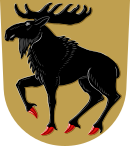
As one of the Canadian national symbols, the moose occurs on several Canadian coats of arms, including Newfoundland and Labrador,[202] and Ontario.[203] Moose is also a common coat of arms in Europe as well; for example, in Finland, it appears on the coats of arms of Hirvensalmi and Mäntsälä municipalities.[204] The Seal of Michigan features a moose.[205]
See also
- Älgen Stolta, a rare example of a domesticated moose
References
- . Retrieved 19 November 2021.
- ^ "Alces alces". NatureServe Explorer. Retrieved 17 April 2024.
- ^ a b c d "elk, n. 1". Oxford English Dictionary (2nd ed.). 1989 [1891]. Retrieved January 15, 2021.
- Perseus Project.
- Perseus Project.
- ^ "alce, n.". Oxford English Dictionary (3rd ed.). 2012. Retrieved January 15, 2021.
- ^ Mallory, J. P.; Adams, D. Q. (2006). The Oxford introduction to Proto-Indo-European and the Proto-Indo-European World. Oxford University Press. pp. 133–134.
- ^ Bailey, Nathan (1731). An Universal Etymological English Dictionary Royal Exchange. Page EL--EM.
- ^ "moose". Oxford English Dictionary (Online ed.). Oxford University Press. (Subscription or participating institution membership required.)
- ^ "moose". Oxford English Dictionary (Online ed.). Oxford University Press. Retrieved February 16, 2011. (Subscription or participating institution membership required.)
- ^ "moose". Dictionary.com Unabridged (Online). n.d. Retrieved October 25, 2011.
- ^ "Moose Facts from Maine". Jackman, Maine Chamber of Commerce. Archived from the original on September 3, 2009. Retrieved November 27, 2009.
- ISBN 978-1135285975.
- ^ "Moose". Environment and Climate Change Newfoundland and Labrador. Archived from the original on January 2, 2008. Retrieved November 27, 2009.
- ^ Franzmann, A. W. (1981). Alces alces. Mammalian Species, 1-7.
- ISBN 978-0-8018-5789-8
- ^ a b Long, Nancy; Savikko, Kurt (August 7, 2009). "Moose: Wildlife Notebook Series". Alaska Department of Fish and Game. Archived from the original on November 30, 2009. Retrieved November 27, 2009.
- ^ ISBN 978-0-85112-235-9
- ^ "World Record Moose Hunting". moosehuntinginfo.com. Retrieved 22 January 2024.
- ^ ISBN 978-0-89658-521-8
- S2CID 129492491.
- JSTOR 23736846. Retrieved May 2, 2020.
- S2CID 44737101.
- James Randerson (March 20, 2008). "Moose's sharp hearing is attributed to antlers". The Guardian.
- ^ ISBN 1-56098-775-8.
- ^ ISBN 978-1-4613-8968-2.
- ^ Geist, Valerius (1998) Deer of the World: Their Evolution, Behaviour, and Ecology. Archived September 23, 2021, at the Wayback Machine. Stackpole Books. p. 244.
- ^ It's a Bull Moose...No a Cow... Archived January 20, 2012, at the Wayback Machine Joe Viechnicki, KFSK – Petersburg 10-19-09
- ^ a b Pagano, Anthony Santino, Jeffrey T. Laitman, Kurt Albertine, and Samuel Marquez. "Evolution of the proboscis in the moose, Alces alces: Evidence from Morphology and Ecology." The FASEB Journal 33, no. 1_supplement (2019): 767-19.
- ^ Márquez, Samuel, Anthony S. Pagano, Carrie S. Mongle, Kurt H. Albertine, and Jeffrey T. Laitman. "The Nasal Complex of a Semiaquatic Artiodactyl, the Moose (Alces alces): Is it a Good Evolutionary Model for the Ancestors of Cetaceans?." The Anatomical Record 302, no. 5 (2019): 667-692.
- ^ Keller, Anna, Marcus Clauss, Evelyne Muggli, and Karl Nuss. "Even-toed but uneven in length: the digits of artiodactyls." Zoology 112, no. 4 (2009): 270-278.
- ^ Lundmark, Caroline. Morphological and behavioral adaptations of moose to climate, snow, and forage. Vol. 2008, no. 67. 2008.
- ^ Telfer, Edmund S., and John P. Kelsall. "Adaptation of some large North American mammals for survival in snow." Ecology 65, no. 6 (1984): 1828-1834.
- ^ Sokolov, V. E.; Chernova, O. F. (1987). "Morphology of the skin of moose (Alces alces L.)". Swedish Wildlife Research (Sweden). Archived from the original on 2022-11-30. Retrieved 2022-11-30.
- ^ "Big Game Hunting in Newfoundland". Newfoundland Big Game Hunting. January 17, 2016. Archived from the original on January 4, 2017. Retrieved June 4, 2018.
- ^ Sokolov, V.E.; Chernova, O.F. (1987). "Morphology of the skin of moose (Alces alces L.)". Swedish Wildlife Research. Suppl.: 367–375. Retrieved 4 November 2023.
- ^ "Moose". britannica.com. July 23, 1999. Archived from the original on October 2, 2018. Retrieved October 2, 2018.
- PMID 27437025.
- ^ "Alces alces, Giant of the Northern Forest". bioweb.uwlax.edu. Archived from the original on February 8, 2018. Retrieved October 2, 2018.
- ^ Report of the Cooperative Wildlife Research Unit Calendar Year 1971 (Report). Washington, D. C.: United States Department of the Interior Fish and Wildlife Service. 1972. Retrieved 22 January 2024.
- ^ Moose diet Archived November 25, 2010, at the Wayback Machine Mooseworld. Retrieved on January 9, 2011.
- ^ a b Burton, Richard F. (1998). Biology by numbers: an encouragement to quantitative thinking. Cambridge University Press. pp. 84–85.
- ^ Harris, Patricia; Lyon, David (1999). Journey to New England. Patricia Harris-David Lyon. p. 398.
- ISBN 978-0-89658-521-8
- ^ Promack, Jennie; Sanker, Thomas J. (1992). Seasons of the Moose. Gibbs Smith. p. 21.
- ^ "Moose diet". Mooseworld. Archived from the original on November 25, 2010. Retrieved January 9, 2011.
- ^ Dalrymple, Byron (1983). North American big-game animals. Stoeger Publishing. p. 84.
- ^ Farb, Peter (1966). The Land and Wildlife of North America. California State department of Education. p. 177.
- ISBN 0802070213. Retrieved August 28, 2020.
Water is definitely one of the preferred elements in the habitat of moose. When feeding on submerged aquatic vegetation they occasionally dive for plants in water over 18 feet deep.
- ^ a b Geist, Valerius (1998). Deer of the World: Their Evolution, Behaviour, and Ecology. Stackpole Books. p. 237.
- ^ Sharp, David. "Researchers take a look at the moose's enigmatic nose". USA Today. Associated Press. Archived from the original on May 18, 2014. Retrieved May 18, 2014.
- ^ Cheeke, Peter R.; Dierenfeld, Ellen Sue (2010). Comparative Animal Nutrition and Metabolism. CABI. p. 24.
- ^ Mowry, Tim (December 26, 2003). "Deadly diet of hay can bring down a moose". Fairbanks Daily News-Miner. Archived from the original on March 1, 2016 – via Juneau Empire.
- ISBN 978-1-84593-926-7.
- ^ Tigris Foundation dedicated to the survival of the Amur tiger and leopard in the wild : UK HOME Archived August 17, 2011, at the Wayback Machine. Tigrisfoundation.nl (November 13, 1999). Retrieved on 2011-01-09.
- ^ Hayward, M. W., Jędrzejewski, W., & Jedrzejewska, B. (2012). Prey preferences of the tiger Panthera tigris. Journal of Zoology, 286(3), 221-231.
- ^ Long, Nancy; Savikko, Kurt (December 17, 2007). "Wolf: Wildlife Notebook Series – Alaska Department of Fish and Game". Adfg.state.ak.us. Archived from the original on November 15, 2010. Retrieved November 27, 2009.
- S2CID 266933839.
- ^ Long, Nancy; Savikko, Kurt (August 7, 2009). "Brown Bear: Wildlife Notebook Series – Alaska Department of Fish and Game". Adfg.state.ak.us. Archived from the original on November 29, 2009. Retrieved November 27, 2009.
- ^ Opseth, O. (1998). Brown bear (Ursus arctos) diet and predation on moose (Alces alces) calves in the southern taiga zone in Sweden. Cand Sci Thesis, Norwegian University of Science and Technology, Trondheim.
- ^ Mattson, D. J. (1997). Use of ungulates by Yellowstone grizzly bears Ursus arctos. Biological Conservation, 81(1), 161-177.
- (PDF) from the original on December 17, 2008. Retrieved December 10, 2008.
- ^ "Hinterland Who's Who – Cougar". Hww.ca. Archived from the original on September 26, 2010. Retrieved November 27, 2009.
- ^ "Wolverine Species Profile, Alaska Department of Fish and Game". www.adfg.alaska.gov.
- ^ Scrafford, Matthew A., and Mark S. Boyce. "Temporal patterns of wolverine (Gulo gulo luscus) foraging in the boreal forest." Journal of Mammalogy 99, no. 3 (2018): 693-701.
- ^ "Gulo gulo – The American Society of Mammalogists" (PDF). smith.edu. Archived from the original (PDF) on June 17, 2012. Retrieved June 22, 2012.
- ISBN 978-0-7603-2654-1. Archivedfrom the original on July 21, 2011. Retrieved February 2, 2011.
- ^ "Moose-eating shark rescued in Newfoundland harbour". CBC Newfoundland & Labrador. Canadian Broatcasting Corporation. Archived from the original on May 23, 2016. Retrieved May 15, 2016.
- OCLC 80431846. Archived from the originalon August 2, 2009.
- ^ "Watching Wolves On a Wild Ride By Les Line, National Wildlife Federation, December/January 2001, vol. 39 no. 1". Nwf.org:80. Archived from the original on March 8, 2008. Retrieved February 16, 2011.
- ^ "Alaska Science Forum, June 10, 2004 Are ravens responsible for wolf packs? Article #1702 by Ned Rozell". Gi.alaska.edu. June 10, 2004. Archived from the original on November 24, 2010. Retrieved February 16, 2011.
- ISBN 9780691152288
- ^ Berger, Joel; Swenson, Jon E.; Persson, Inga-Lill Recolonizing Carnivores and Naive Prey: Conservation Lessons from Pleistocene Extinctions. Science September 2, 2001
- ^ Jaenson, Thomas G.T. (2011). "Larver av nässtyngfluga i ögat - ovanligt men allvarligt problem. Fall av human oftalmomyiasis från Dalarna och sydöstra Finland redovisas (summary)". Läkartidningen. 108 (16). Archived from the original on September 27, 2011. Retrieved June 21, 2011.
Moose bot fly larvae are common parasites of moose (Alces alces) in north and central Sweden. Last year, however, C. ulrichii was on three occasions recorded for the first time from Småland, south Sweden.
- .
- PMID 33996444.
- S2CID 220526796.
- S2CID 19770221.
- ^ Miquelle, Dale G. "Why don't bull moose eat during the rut?." Behavioral Ecology and Sociobiology 27, no. 2 (1990): 145-151.
- ^ DW Hartt, Data; Coordinator, Web. "Moose Reproduction". Archived from the original on April 24, 2008. Retrieved February 16, 2011.
- ISBN 978-1-56098-845-8.
- Minnesota DNR. Archived from the originalon December 7, 2009. Retrieved November 11, 2009.
- ^ a b Crichton, Vince; A. T. Bergerud; James-Abra, Erin. "Moose". The Canadian Encyclopedia. Retrieved September 1, 2019.
- ^ Adventure Guide Inside Passage & Coastal Alaska By Ed Readicker-Henderson, Lynn Readicker-Henderson – Hunter Publishing 2006 Page 49
- ^ "What To Do About Aggressive Moose, Division of Wildlife Conservation, Alaska Department of Fish and Game". wildlife.alaska.gov. Archived from the original on November 5, 2009. Retrieved November 6, 2009.
- ^ Adventure Guide Alaska Highway By Ed Readicker-Henderson, Lynn Readicker-Henderson – Hunter Publishing 2006 Page 416
- ^ Explorer's Guide 50 Hikes Around Anchorage By Lisa Maloney – The Countryman Press 2010 Page 16
- ^ Field & Stream Aug 2002 – Page 75--77
- ^ Wilderness Camping & Hiking By Paul Tawrell – Exxa Nature 2007 Page 161
- S2CID 20008798.
- ^ US Fed News Service, Female moose moans provoke bull fights, females have more choice in picking mates, concludes Idaho state university study March 8, 2011
- ^ v.106 (1992) – The Canadian field-naturalist. Vol. 106. 21 February 1992. Retrieved 22 August 2021.
- ^ Weaver, J.L., C. Arvidson, and P. Wood. 1992. Two Wolves, Canis lupus, killed by a Moose, Alces alces, in Jasper National Park, Alberta. Canadian Field-Naturalist 106(1): 126-127.
- ^ a b Rines, Kristine. New Hampshire's moose population vs climate change (PDF) (Report). New Hampshire Fish and Game Department. Archived (PDF) from the original on May 16, 2018. Retrieved May 15, 2018.
- ^ Dussault, Christian, Jean‐Pierre Ouellet, Réhaume Courtois, Jean Huot, Laurier Breton, and Hélène Jolicoeur. "Linking moose habitat selection to limiting factors." Ecography 28, no. 5 (2005): 619-628.
- S2CID 49315294.
- ^ a b c Robbins, Jim (October 14, 2013). "Moose Die-Off Alarms Scientists". New York Times. Archived from the original on December 10, 2013. Retrieved December 6, 2013.
- ^ "Solved: Deer have direct role in death of Minnesota moose". Star Tribune. Archived from the original on April 20, 2019. Retrieved April 20, 2019.
- ^ "Moose population decline". 2 December 2014. Archived from the original on 2023-11-05. Retrieved 2023-11-05.
{{cite web}}: CS1 maint: bot: original URL status unknown (link) - ^ "Moose | North Dakota Game and Fish". gf.nd.gov.
- ^ Wattles, David W.; DeStefano, Stephen (13 January 2011). "STATUS AND MANAGEMENT OF MOOSE IN THE NORTHEASTERN UNITED STATES". Alces: A Journal Devoted to the Biology and Management of Moose. 47: 53–68.
- ^ "Moose - NYS Dept. of Environmental Conservation". www.dec.ny.gov.
- ^ "Utah Division of Wildlife Resources". Wildlife.utah.gov. April 28, 2006. Archived from the original on October 5, 2007. Retrieved November 27, 2009.
- ^ "Oregon moose population is booming". The Seattle Times. August 21, 2006. Archived from the original on April 17, 2010. Retrieved August 19, 2010.
- ^ "ODFW Oregon Conservation Strategy News". Dfw.state.or.us. Archived from the original on July 6, 2013. Retrieved June 27, 2013.
- ^ a b Wolfe, Michael L.; Hersey, Kent R.; Stoner, David C. (2010). "A History of Moose Management in Utah". Alces. 46: 37–52. Retrieved January 2, 2017.
- ^ Nadeau, M. Steven; DeCesare, Nicholas J.; Brimeyer, Douglas G.; Bergman, Eric J.; Harris, Richard B.; Hersey, Kent R.; Huebner, Kari K.; Matthews, Patrick E.; Thomas, Timothy P. (2017). "Status and trends of moose populations and hunting opportunity in the Western United States" (PDF). Washington Department of Fish and Wildlife.
- ISBN 978-0-932027-71-9. Archivedfrom the original on October 9, 2013. Retrieved June 25, 2011.
- ^ a b Wattles, David W. (2011). STATUS, MOVEMENTS, AND HABITAT USE OF MOOSE IN MASSACHUSETTS (PDF) (M.S. thesis). University of Massachusetts Amherst. Archived from the original on December 2, 2013. Retrieved November 22, 2013.
- ^ "Survey estimates Maine has 76,000 moose". The Portland Press Herald / Maine Sunday Telegram. September 7, 2012. Archived from the original on December 2, 2013. Retrieved November 9, 2012.
- ^ Wattles, David (2011). Status, Movements, and Habitat Use of Moose in Massachusetts. University of Massachusetts MS thesis. Archived from the original on December 2, 2013. Retrieved November 22, 2013.
- ^ Living With Moose Archived June 8, 2010, at the Wayback Machine. Mass.gov (September 20, 2007). Retrieved on 2011-01-09.
- ^ Maine Department of Inland Fisheries and Wildlife – Moose Hunting Permits Archived October 15, 2007, at the Wayback Machine. Maine.gov. Retrieved on January 9, 2011.
- ^ Connecticut Wildlife Sep/Oct 2004 Archived August 11, 2010, at the Wayback Machine. (PDF). Retrieved on January 9, 2011.
- ^ Moose are on the Loose - Connecticut Public Broadcasting Network Archived June 22, 2010, at the Wayback Machine. Cpbn.org. Retrieved on January 9, 2011.
- ^ Forests lure moose to Massachusetts Archived November 8, 2010, at the Wayback Machine. The Christian Science Monitor (February 14, 2007). Retrieved on 2011-01-09.
- ^ a b "Moose in a Mess? - Defenders of Wildlife". Archived from the original on August 4, 2010. Retrieved August 20, 2010.
- ^ "Moose". Dec.ny.gov. NYS Dept. of Environmental Conservation. July 6, 1999. Archived from the original on July 28, 2011. Retrieved January 9, 2011.
- ^ Franzman, Dave (December 5, 2013). "A Moose Still on the Loose in Eastern Iowa". KCRG News 9. Archived from the original on December 9, 2013. Retrieved December 6, 2013.
- ^ "tm Moose". Newfoundland Coastal Safari. Archived from the original on January 11, 2011. Retrieved February 6, 2011.
- ^ "'Moose die-off' not seen in Yukon, where populations stable". cbc.ca. October 16, 2013. Archived from the original on December 30, 2014. Retrieved December 15, 2014.
- ^ credits Hari Sreenivasan (April 7, 2014). "What's devastating the wild moose population in New England?". PBS Newshour. Archived from the original on April 8, 2014. Retrieved April 8, 2014.
- ^ Brockman, Christopher J., William B. Collins, Jeffery M. Welker, Donald E. Spalinger, and Bruce W. Dale. "Determining kill rates of ungulate calves by brown bears using neck-mounted cameras." Wildlife Society Bulletin 41, no. 1 (2017): 88-97.
- S2CID 226361594.
- ^ a b Cusick, Daniel (18 May 2012). "Rapid Climate Changes Turn North Woods into Moose Graveyard". Scientific American. Springer Nature. Archived from the original on 8 January 2018. Retrieved 8 January 2018.
- (PDF) from the original on November 13, 2018. Retrieved January 8, 2018.
- .
- S2CID 236985989.
- ^ Kusnetz, Nicholas (May 29, 2017). "Climate Change Is Killing New England's Moose. Can Hunters Save Them?". InsideClimate News. Archived from the original on May 20, 2018. Retrieved June 4, 2018.
- ^ "Ticks are killing 70 percent of moose calves across Maine, N.H." The Boston Globe. January 13, 2017. Archived from the original on June 22, 2018. Retrieved June 4, 2018.
- ^ "Moose in New England face grisly deaths from tick infestations". Pri.org. March 18, 2017. Archived from the original on May 20, 2018. Retrieved June 4, 2018.
- ^ MacQuarrie, Brian (January 13, 2017). "Ticks devastate Maine, N.H. moose populations". The Boston Globe. Archived from the original on January 16, 2017. Retrieved January 16, 2017.
- ^ Samuel, W. M. "Grooming by moose (Alces alces) infested with the winter tick, Dermacentor albipictus (Acari): a mechanism for premature loss of winter hair." Canadian Journal of Zoology 69, no. 5 (1991): 1255-1260.
- S2CID 30772675.
- ^ "Elks Make a Dangerous Comeback in Germany". Spiegel. September 3, 2012. Archived from the original on December 25, 2012. Retrieved December 28, 2012.
- ^ a b Alces alces (Eurasian Elk, Moose, Elk, Eurasian Moose, European Elk, Siberian Elk) [dead link]. Iucnredlist.org. Retrieved on January 9, 2011.
- ^ "Wayward elk 'Knutschi' found dead – The Local Archived 2011-05-14 at the Wayback Machine". Thelocal.de. Retrieved on January 9, 2011.
- ^ "Re-Introducing Moose to the Glen – Moose – BBC". 24 April 2009. Archived from the original on 29 April 2009. Retrieved 27 November 2009 – via YouTube.
- ^ Cramb, Auslan; Eccleston, Paul (April 14, 2008). "Moose to roam free again in Scotland". The Telegraph. Archived from the original on January 27, 2010. Retrieved August 7, 2011.
- ^ "European Elk - Alces alces". Alladale Wilderness Reserve. Archived from the original on January 19, 2012. Retrieved August 7, 2011.
- ^ "Elg". Dansk Pattedyratlas. 2007. Retrieved 16 January 2023.
- ^ "Elge formerer sig lystigt: Tre nye elgkalve i Vildmosen". Nordjyske. 2 June 2020. Retrieved 16 January 2023.
- ISBN 978-0-19-558320-5.
- ^ "Deer and deer farming – Introduction and impact of deer". Te Ara – Encyclopedia of New Zealand. March 1, 2009. Archived from the original on December 4, 2011. Retrieved March 27, 2011.
- ^ "Hairs move NZ moose out of realm of Nessie". NZ Herald. October 6, 2005. Archived from the original on November 5, 2020. Retrieved November 4, 2020.
- ^ .
- ^ ISBN 978-3-319-65038-8, retrieved 2023-06-14
- ^ a b Deer of the world: their evolution, behaviour, and ecology By Valerius Geist - Page 244-250
- ^ a b Morphological Change in Quaternary Mammals of North America by Robert Allen Martin, Anthony D. Barnosky - Cambridge University Press 1993 Page 178-181
- )
- ^ "Cervalces latifrons | Natural History Museum". Nhm.ac.uk. Archived from the original on November 2, 2012. Retrieved November 9, 2012.
- S2CID 225467866.
- ^ "Hinterland Who's Who". Hww.ca. Archived from the original on April 24, 2013. Retrieved May 25, 2013.
- ^ "Newfoundland's 120,000 moose are descended from just four that were introduced a century ago". Canadacool.com. Archived from the original on July 24, 2011.
- ^ Interior Alaska Moose News (Fall 2011) Archived February 20, 2016, at the Wayback Machine, p. 6, "How Do Scandinavia and Alaska Compare?"
- ^ "Wyoming moose numbers fall short" Archived April 30, 2017, at the Wayback Machine, Billings Gazette, May 28, 2009
- ^ Isle Royale: Wolf & Moose Populations, National Park Service
- ^ "DNRE Survey Results Indicate Approximately 433 Moose in Western Upper Peninsula". Michigan.gov. May 25, 2017. Archived from the original on October 29, 2013. Retrieved June 4, 2018.
- ^ "2010 Aerial Moose Survey" (PDF). Archived from the original (PDF) on August 8, 2017. Retrieved June 4, 2018.
- ^ "Moose Management and Research Plan Update" (PDF). Archived (PDF) from the original on November 13, 2018. Retrieved June 4, 2018.
- ^ "Big Game Hunting: Moose Season Information" Archived November 9, 2011, at the Wayback Machine, North Dakota Game and Fish Department
- ^ RiistaWeb Archived July 24, 2010, at the Wayback Machine. Riistaweb.riista.fi. Retrieved on January 9, 2011.
- ^ "Elgen truer skogen". Aftenposten (in Norwegian). Archived from the original on November 6, 2016. Retrieved September 19, 2016.
- ^ "Elgjakt, 2015/2016". Statistisk sentralbyrå. 18 March 2016. Archived from the original on December 1, 2017. Retrieved September 19, 2016.
- ^ "zm.gov.lv" (in Latvian). zm.gov.lv. Archived from the original on October 6, 2015. Retrieved October 6, 2015.
- ^ "Põtrade arvukust tahetakse oluliselt vähendada". Archived June 27, 2013, at the Wayback Machine Postimees June 26, 2013. Retrieved June 27, 2013. (in Estonian)
- ^ "Lietuvą pamėgo meškėnai, o rudiesiems lokiams vietos čia per mažai". lrt.lt. February 10, 2017. Archived from the original on January 10, 2019.
- ^ "Zespół Rewilding Oder Delta nastawia się na powrót łosia". 31 March 2021.
- ^ "Factsheet: Eurasian Elk (Elk, reindeer, roe deer (Cetartiodactyla Cervidae Capreolinae) > Alces alces)". Lhnet.org. Archived from the original on July 27, 2013. Retrieved June 27, 2013.
- ^ Baskin, Leonid M. (2009). "Status of Regional Moose Populations in European and Asiatic Russia". Alces. 45: 1–4. Archived from the original on February 26, 2018. Retrieved February 26, 2018.
- ^ "jagareforbundet.se" (in Swedish). jagareforbundet.se. Archived from the original on December 3, 2013. Retrieved December 1, 2013.
- ^ salenalgen.se Om älgar Archived June 20, 2012, at the Wayback Machine
- ^ "Så många djur dödas i trafiken varje år | SvD". Svenska Dagbladet. Svd.se. December 29, 2003. Archived from the original on September 25, 2018. Retrieved June 4, 2018.
- ^ Smith, A. T., Xie, Y., Hoffmann, R. S., Lunde, D., MacKinnon, J., Wilson, D. E., & Wozencraft, W. C. (Eds.). (2010). A guide to the mammals of China Archived September 19, 2015, at the Wayback Machine. Princeton University Press.
- ^ a b c "Asian Moose". Bear Creek Journal. Archived from the original on June 20, 2013. Retrieved June 27, 2013.
- ^ Kevin Jackson, 2009, Moose, Reaktion Books
- ^ Jackson, K. (2009). Moose. Reaktion Books.
- ^ "Moose in British Columbia" (PDF). Ministry of Environment, Lands and Parks, British Columbia. Archived (PDF) from the original on December 22, 2014. Retrieved August 18, 2014.
- ^ Franzmann, A. W., LeResche, R. E., Rausch, R. A., & Oldemeyer, J. L. (1978). Alaskan moose measurements and weights and measurement-weight relationships. Canadian Journal of Zoology, 56(2), 298-306.
- ^ "Moose Status and Hunting in Washington By Dana L. Base, Associate Wildlife Biologist August 2004". Archived from the original on June 21, 2007. Retrieved December 7, 2009.
- ISBN 9780080488820.
- ISBN 978-0-217-45287-8.
- ^ John Bostock; Henry Thomas Riley (eds.). "Pliny the Elder, The Natural History". Archived from the original on 2012-07-13. Retrieved 2009-11-08.
- ^ "Moose, meat, raw (Alaska Native)". Nutrition Data. Archived from the original on May 21, 2008. Retrieved February 16, 2011.
- ^ "adn.com". Archived from the original on February 13, 2009.
- ^ Aerial Hunting FAQs Archived July 12, 2010, at the Wayback Machine, Defenders of Wildlife - Protect America's Wildlife (PAW) Act - Aerial hunting FAQs
- ^ "All-clear for Finnish foods". Food Quality News. Archived from the original on November 10, 2009. Retrieved November 6, 2009.
- PMID 3381081.
- ^ "Health and Wellness Public Health Advisory / Hunters and wildlife diseases (05/09/16)". No. NB 1188. www.gnb.ca. New Brunswick Chief Medical Officer of Health. September 16, 2005. Archived from the original on July 3, 2019. Retrieved July 3, 2019.
- ^ Vahteristo, L., Lyytikäinen, T., Venäläinen, E. R., Eskola, M., Lindfors, E., Pohjanvirta, R., & Maijala, R. (2003). Cadmium intake of moose hunters in Finland from consumption of moose meat, liver and kidney. Food Additives and Contamination, 20, 453–463.
- ^ "Archived copy" (PDF). Archived (PDF) from the original on March 11, 2012. Retrieved October 4, 2011.
{{cite web}}: CS1 maint: archived copy as title (link) - ^ Traffic Management for a Sustainable Environment Number 2, 2004, of Nordic Road & Transport Research. Annotations Sweden
- S2CID 13700403.
- ^ (in Swedish) "Älgsafari lockar tusentals turister[permanent dead link]", Dagens Nyheter, August 12, 2007. Accessed November 6, 2009."
- ^ Hamr, Joe, Mike Hall, and Jesse N. Popp. "AN ASSESSMENT OF MOOSE AND ELK TRAIN COLLISIONS IN ONTARIO, CANADA." Alces: A Journal Devoted to the Biology and Management of Moose 55 (2019): 1-12.
- ^ "Railroad takes steps to reduce moose crashes". Aftenposten. January 28, 2008. Archived from the original on September 28, 2008.
- ^ Moose-Vehicle Collision Information Archived January 14, 2007, at the Wayback Machine, New Brunswick Department of Transportation
- ^ More wildlife fencing to be installed on Route 7 in 2008 Archived January 17, 2011, at the Wayback Machine, Communications New Brunswick, April 8, 2008
- ^ "Highway Driving Conditions – Department of Transportation and Works". www.roads.gov.nl.ca. Archived from the original on May 13, 2008. Retrieved November 6, 2009.
- ^ "Moose detection lights being removed, 'not effective' for N.L." CBC News. February 10, 2015. Archived from the original on November 23, 2015. Retrieved February 11, 2018.
- ^ (in Swedish) Många viltolyckor – inget görs – Mellerud Archived July 19, 2011, at the Wayback Machine. www.ttela.se (December 21, 2010). Retrieved on 2011-01-09.
- ^ Björklöf, Sune. (1995). "Har älgar tämjts till kavalleri?" Archived July 14, 2011, at the Wayback Machine, Populär Historia, no 5. Visited May 17, 2010.
- ^ "The Newfoundland Quarterly, volume 057, no. 2 (June 1958) :: Newfoundland Quarterly". collections.mun.ca. Retrieved 2021-04-14.
- ^ "Coat of arms of Ontario – Government of Ontario".
- ISBN 951-773-085-3.
- ^ "SOS - History of the Great Seal and Coat of Arms". www.michigan.gov. Retrieved 29 September 2021.
Further reading
- Alces: A journal devoted to the biology and management of moose (Alces alces) Centre for Northern Forest Ecosystem Research.
- DuTemple, Lesley A. (February 1, 2000). North American Moose. Lerner Publications. ISBN 9781575054261.
- Geist, Valerius; Francis, Michael H. (November 1999). Moose: Behavior, Ecology, Conservation. Voyageur Press (MN). ISBN 978-0-89658-422-8.
- Promack, Jennie; Sanker, Thomas J. (June 1, 1992). Seasons of the Moose. Gibbs Smith. ISBN 9780879054557.
- Strong, Paul (May 1998). Wild Moose Country (illustrated ed.). Cowles Creative Publishing. ISBN 978-1-55971-638-3.
External links
- "Alces alces". Integrated Taxonomic Information System.
- A moose in the National Nature Park "Losinyj Ostrov" ("Moose" or "Elk" Island) in Russia
- "North American Mammals: Alces alces". Archived from the original on 2016-01-22. Retrieved 2007-01-28. from the National Museum of Natural History



